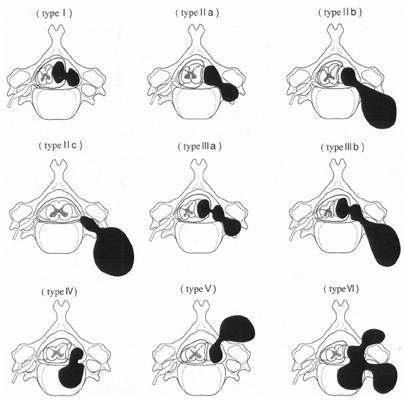Spinal dumbbell tumor
Love and Dodge 1) in 1952 first coined the term dumbbell tumor, reporting a neurogenic tumor with in growths into the spinal canal. In addition, these tumors may grow extensively outside the spinal canal and compress the paraspinal-iliopsoas complexes as well as retroperitoneal vascular structures.
Dumbbell appearance of spinal tumors refers to a tumour which has both a component within the canal and a component in the paravertebral space linked by tumour traversing the neural exit foramen.
They are constricted at the point they penetrate the intervertebral foramina or dura mater, assuming an hourglass (dumbbell) shape. Currently, however, the term “dumbbell tumors” does not refer to the hourglass shape but stands as a conceptual term, meaning separate tumors that connect and comprise two or more separate regions, such as the intradural space, epidural space, and locations outside the paravertebral space 2).
Types
see Cervical spinal schwannoma.
see Thoracic spinal schwannoma.
Not all are Schwannomas e.g. neuroblastoma.
Most have a contigous intraspinal, foraminal (usually narrower) and extraforaminal components (widening of the neural foramen is a characteristic finding, can be recognized even on plain films, and speaks to the longstanding benign nature of the lesion). The waist may also be due to a dural constriction.
see Dumbbell shaped mesenchymal chondrosarcoma.
Asazuma et al. classification system for dumbbell spinal schwannoma:
Ito et al., report on a new method for removing dumbbell-shaped spinal tumors that avoids the risk of postoperative Cerebrospinal fluid fistula. Adequate visualization of the intra- and extradural components of the tumor is achieved with the use of separate dural incisions. First, the dura mater is opened along the dural theca to provide adequate visualization of the intradural portion of the mass; then, a second incision is made along the spinal nerve root to remove the extradural component. Meticulous suturing is essential in intradural lesion cases; however, the dura mater is usually thin and fragile in such cases. During suturing with a needle and thread, the dura mater can become lacerated proximal to the needle holes and result in Cerebrospinal fluid fistula.
In this technique, instead of using a needle and thread, nonpenetrating vascular clips were used to close the dural incisions. When operating on dumbbell-shaped spinal tumors, the authors found that the “separate-dural-incision method” was preferable to the conventional T-shaped dural incision method because no dural defects occurred after the intradural procedure and meticulous dural closure with vascular clips was achieved. The authors conclude that the novel separate-dural-incision method for removing dumbbell-shaped tumors and the use of nonpenetrating vascular clips permits reliable dural closure, prevents postoperative Cerebrospinal fluid fistula, and promises good postoperative clinical results 3).
Case series
Müther et al. from the Münster University Hospital presented a technical note and according case series of seven patients with dumbbell tumors in the lumbar and thoracolumbar spine operated on between 2017 and 2020. CFR-PEEK pedicle screws and rods were inserted percutaneously. Afterwards, a dedicated self-standing retractor for posterolateral approaches was connected to the screws. Following a unilateral facetectomy the tumor was resected in a microsurgical fashion. Clinical data are reported with respect to the PROCESS guidelines.
Four patients presented with de-novo tumors. Three patients were treated for residual tumor mass after previous surgeries. Gross-total resection was achieved in all seven cases as demonstrated by early postoperative MRI. Histopathology demonstrated five WHO grade I schwannomas, one grade II hemangiopericytoma and one cavernous hemangioma. No postoperative complications were observed. CFR-PEEK hardware allowed unambiguous visualization of the resection cavity on follow-up imaging.
Resection of dumbbell tumors via a minimally-invasive posterolateral approach and instrumentation with CFR-PEEK hardware allows maximal and safe resection. Due to lack of major metal artifacts, carbon fiber hardware improves the interpretation of follow-up imaging as well as planning of radiation if required for tumor recurrence 4).

